I’ve been meaning to tackle this topic for some time, but it always seemed to be a little daunting. It still does, but I think if I keep it to the basics (more or less) it might be workable. Considering the plethora of comic book movies that keep festooning our theaters, I certainly feel that some understanding of how this all started is of some interest, particularly with Iron Man 2 on the horizon as one of most anticipated films of the year—or so the endless promotion of it assures us.
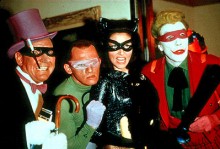
It may be hard to believe, but there was a time when the comic book movie was neither anticipated, nor was it hyped. (Let’s be clear—when I use the term “comic book movie” I’m specifically referring to the superheroes-in-tights variety. Adaptations of less fanciful graphic novels are a separate proposition of more recent origin.) As recently as 1966 when Leslie H. Martinson’s Batman brought the Adam West TV series to the big screen, it was hardly an event. It was a relatively cheap attempt to cash in on the popularity of the show—and it looked even cheesier when blown up to the big screen. (If you thought the greasepaint over Cesar Romero’s mustache looked lame on TV, just imagine what his Joker looked like when his face was 15 feet wide.) At best, it was moderately successful at the box office, primarily as Saturday matinee kiddie fare. Ironically, it jumped right in doing the very thing that fans tend to decry about comic franchises today—stuffed itself with multiple villains like one of those late-in-the-day Universal “monster rallies” in the 1940s.
The first time that a comic book movie made a splash of significant import was with the 1978 Richard Donner Superman and Richard Lester’s Superman II (1980), but even these—large and popular as they were—were not entirely serious-minded affairs. The tone was often campy and the villains were very broadly conceived and played. It really wasn’t until Tim Burton’s Batman in 1989 that a reasonably serious and dark comic book movie came out .And that owed much to the tone of the modern comics, which, in themselves, had more in common with the earliest adventures of Batman in Detective Comics in 1939.
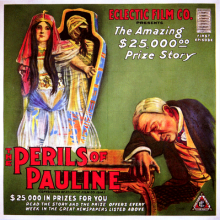
But what started all this in the movies is something else again. Technically, the first comic book movies weren’t comic book movies at all—they were comic strip movies. And they started life as that most ghettoized of movie creations, the serial. In the very early days of movies—and even into the 1920s—the serial, or chapter play, was not aimed at a specific demographic. Things like The Perils of Pauline (1914) and The Exploits of Elaine (1914) were enjoyed by relatively undemanding audiences of all ages. The first Charlie Chan movie (now lost) The House Without a Key (1925) was a serial. As time passed, however, the serial became more and more the staple of the kiddie matinee idea. When Sherman Krellberg’s infamous (and jaw-droppingly racist) The Lost City came out in 1935, its horror content was so strong that it was pulled from many theaters because it scared children.

In 1936 Universal Pictures made a largely successful effort to create a serial that had adult appeal—and they dumped a fair sum to bring Alex Raymond’s comic strip (“cartoon strip” is how the credits refer to it) Flash Gordon to the screen. Somewhere in the neighborhood of $350,000 went into the making of the serial—an unheard of amount for a serial and pretty substantial for any Universal offering of the era. (Though it ended up costing more, their big production of Bride of Frankenstein the previous year was budgeted at less.) It all looked somewhat more elaborate than it was thanks to recycled sets and props from the studio’s horror films and even footage borrowed from other movies. (There’s an “erotic” dance involving a giant idol that looks suspiciously like it was taken from the 1930 Fox film Just Imagine, and it’s obviously just inserted since none of the characters in Flash Gordon are ever in the frame with this footage.) The impressive musical score is also pilferred from Universal’s library—again mostly from horror movies. But it all made an impression in 1936 and paved the way for two sequel serials.
For better or worse, Flash Gordon is the first comic book—or strip—movie. At the time, it definitely made its mark, its popularity insured to some degree by being a reasonably faithful adaptation of the first storyline from the Alex Raymond comic. Peculiarly, Universal handed the directing chores to writer Frederick Stephani, who previously and subsequently never directed a theatrical film. You might have thought they would have insisted on an experienced director, but to this end they did bring in serial veteran Ray Taylor (uncredited) to punch things up.
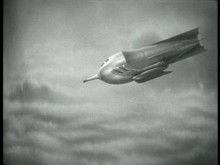
Seen today, it’s hard to imagine adults taking Flash Gordon very seriously. Its science is laughable. Its special effects aren’t much better. Its exotic monsters—including iguanas with things glued to them and a man-in-a-rubber-suit dragon with limp-wristed lobster claws—are amusingly hokey. The acting might best be called preposterously stoic with flashes of ham. The action is simplistic and most of it wouldn’t hold up against that seen in a B western barroom brawl. And its storyline is somewhere in the borderland of serviceable and silly. None of which keeps the film from exerting a strange fascination. In fact, its quaintness is part of that fascination.
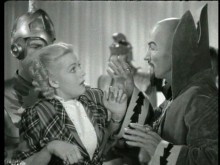
Where the proceedings fall down on a technical level, they more than make up for it unbridled—possibly unhinged—imagination that often feels like surrealism crossed with a Wagner opera. Depending on where you look—and with 13 chapters, you have a little over four hours of places to look—you encounter cheesy dinosaurs, dubious rocketships of various designs, hawk men (with preposterously cumbersome molded resin wings), tiger men, shark men, an ape with a cow horn stuck in the middle of his head, a bear with stripes painted on him, a city that floats in the sky on atomic rays, etc. The film’s design is marvelously eclectic. Costuming ranges from comic strip basic to ancient Roman to knights-of-the-roundtable chic, to harem girl fantasy to opera epic. The sets comingle Metropolis (1927) with art deco, Egyptian and gothic horror.
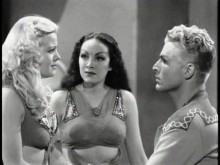
The whole dynamic of the evil Ming the Merciless (Charles B. Middleton) and his not so evil, but libido-charged, daughter, Princess Aura (Priscilla Lawson), is ripped off from that of Dr. Fu Manchu and his daughter, Fah Lo Suee. Ming’s also vaguely Asian, extending the racist notion of the “Yellow Peril” into outer space. This ,of course, means he’s all a-dither over Dale Arden (Jean Rogers) when he first gets a look at her blonde tresses. Aura has similar responses to the equally blonde Flash (Buster Crabbe), but even though she’s all hot-and-bothered over his large-and-sinewy muscles, she turns out not to be so bad. Still, she’s obviously not a good girl, because she’s bustier than Dale and isn’t reticient about showing this off.
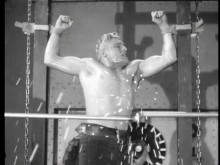
The movie’s not without its beefcake either. Not only is Flash decked out in what appear to be lttle more than tarted-up B.V.D. briefs, but the film is very adept at finding ways to get his shirt off—either through arbitrarily ripping it up in fight scenes, or for the express purpose of the express purpose of showing off Buster Crabbe’s chest. On one occasion, this is even indulged in for what can only be called a sado-masochistic torture scene. In terms of subtext, the sexuality of the serial is the most adult thing about it.
For all its shortcomings—which are many—there is a kind of idiot grandeur to it all. The biggest stumbling block is the length of its serial structure. Anyone sitting down to tackle all 245 minutes in one sitting is going to ultimately find it pretty tough going by the one hour mark. But it was never meant to be seen in a single sitting. Among other things, the filmmakers were counting on the episodes being separated by a week so the viewer might not notice how the next chapter often cheats the cliffhanger ending of its predecessor. At most, these things should be viewed no more than a couple chapters at a time.
Though Flash Gordon qualifies as the first comic-to-screen movie, the influence of its Wagnerian opera tone is in little evidence in its modern counterpart. In fact, its influence is far more noticeable in the George Lucas Star Wars films. In tone and approach, Lucas’s movies are very similar. The special effects may be better, but the rest isn’t all that different—right down to Lucas’ clunky diaogue. The primary difference is that the Star Wars movies are more self-aware. That may or may not be an improvement, depending on your outlook.
The serials that immediately follow—Flash Gordon’s Trip to Mars (1938), Buck Rogers (1939) and Flash Gordon Conquers the Universe (1940)—are pretty much more of the same. It’s interesting that it took Universal so long to tackle Buck Rogers since that comic strip first appeared in 1929. Flash Gordon was a direct attempt to copy its success and didn’t come around till 1934.
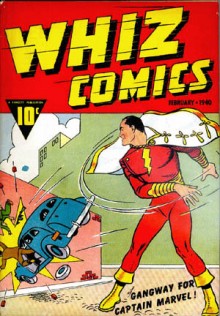
It wasn’t until 1941 that Republic Pictures brought an actual comic book to the screen Adventures of Captain Marvel, adapted from the character created by artist C.C. Beck and writer Bill Parker. Captain Marvel made his debut in Whiz Comics in 1940. The premise of Captain Marvel is that he’s little more than a kid, Billy Batson, who is given the power to transform into superhero Captain Marvel by invoking the name, “Shazam,” which just happens to be that of the wizard who granted him this power. Of course, as with all such gifts, it has stipulations—mostly that the power only be used in the service of good. Now, Captain Marvel is a bonafide superhero with supernatural strength and the ability to fly—rather like Superman. (In fact, the Superman folks eventually sued.) He’s also supposed to be super smart, though there’s little actual evidence of this in the serial. Also, at least so far as the serial is concerned, he doesn’t appear to be quite indestructible, since in one episode the Captain appears to be in mortal peril from a potentially exploding airplane.
While it would be hard to call the Republic serial an adult work, it does offer less in the way of unintentional laughs as Universal serials. This is partly due to the fact that it’s never as absurdly ambitious as the Flash Gordon serials, but it’s also due to superior effects work by the studio’s resident effects wizards, the Lydecker Brothers, whose model work was always top notch. Most of it even looks pretty darn good today.
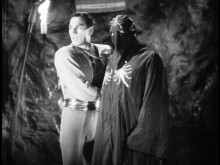
The effects, the fights and the production values are all impressive, but the serial suffers a bit from the old gag of making villain—known as the Scorpion (a fact telegraphed by his outfit)—an unknown quantity. The idea is that neither the viewer, nor the characters know the identity of the story’s evil genius. Indeed, he is apparently one of the film’s supposed good guys. That’s fine in one sense as a running plot device, but it plays hell with painting a very persuasive or colorful picture of the evil genius. Long before it’s over, it’s hard not to wish for some of old Ming’s ill-tempered nastiness. All the same, Tom Tyler makes for a pretty good Captain Marvel and the overall cast isn’t bad—though the comic relief of William Benedict is on the tiresome side.
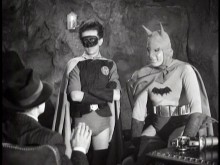
With this successfully made and popular, Batman finally made his way to the serial screen in 1943 with Batman—at least more or less. For reasons of satisfying the production code, Batman (Lewis Wilson) wasn’t a vigilante, but a government agent, making his actions more palatable (even if the police department is unaware of his status). Moreover, the budget prohibited any effort at a Batmobile and Batman and Robin (Douglas Croft) are chauffered around by Alfred (William Austin) in the same limo he drives them around in when they’re Bruce Wayne and Dick Grayson, which seems a bit shy in the secrecy department. Oh, well. More peculiar is the complete lack of Batman villains, who are instead replaced by Dr. Daka (J. Carroll Naish), head of a Japanese spy ring, who hides behind the facade of a cheesy amusement park ride (in the middle of town) that purports to show Japanese atrocties. It’s very much of its time and just as racist as you can imagine.
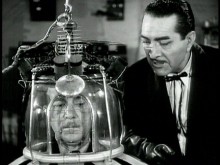
At the same time, it’s not a bad serial—especially one from Columbia Pictures, whose serials were usually pretty awful—and its outrageousness is rather fun. Indeed Dr. Daka is one of the very few screen appearances of J. Carroll Naish where I’m not overwhelmed with the desire to slap him around on general principles. Actually, it had its own impact on the comics. The serial’s “bat’s cave” is the origin of the Batcave. William Austin—a reasonably popular supporting comic at the dawn of sound—as Alfred became the model for how Alfred came to be represented in the comics, too, and then there’s the secret entrance through the grandfather clock. It can certainly be argued that the depiction of Bruce Wayne as idle playboy gets old, and much of the film is silly in terms of plotting. (Does the big hulking goon just stand in that one spot in the atrocity ride in case someone happens along who needs bludgeoning? He must get awfully tired.)
In the end, Flash Gordon and its sequels, plus Buck Rogers, Adventures of Captain Marvel and Batman may lack the weightiness of the modern comics-to-film works that have become such a big deal on movie screens. They aren’t weighty at all, if it comes to that. They certainly lack the effects and the production values of their modern counterparts. But they got there first—in all their amazing tomfoolery—and they really do deserve to be remembered.




Ken, this is such a great article. I can’t stop laughing long enough to write anything intelligent, but good work.
Even Captain America and the Blackhawks had their turn in the serials, as did Superman. And let’s not forget that radio may have had some influence in bringing these characters to the screen as well, with many characters having radio shows prior to the movies. Certain elements that are now considered “canon” had their beginnings in radio. Superman and Batman first teamed up there, and Kryptonite originated in the radio show.
Great article! But no mention of Dick Tracy? For shame!
It should be noted that before even the serials, one of the very first animated cartoons ever made, Winsor McKay’s “Little Nemo”, was based on a comic. It can truly be said that as long as there have been movies, there have been comics based movies. It just took a very long time for filmmaking technology to catch up to the comics’ imagination.
Even Captain America and the Blackhawks had their turn in the serials, as did Superman.
Yes, I know, but I had to draw a line somewhere in order to get this done just to make this tractable. (Then again, have you ever tried sitting through Captain America?)
And let’s not forget that radio may have had some influence in bringing these characters to the screen as well, with many characters having radio shows prior to the movies
Granted, and I considered dragging in such things as Chandu the Magician and its Ray Taylor serial counterpart Return of Chandu, which came directly from radio — and again, time and keeping this at a reasonable length played a huge factor in what was and wasn’t included.
Great article! But no mention of Dick Tracy? For shame!
That was deliberate. I left him out because I don’t think he actually qualifies for superhero status and the film versions of that comic strip aren’t as important or iconic.
It should be noted that before even the serials, one of the very first animated cartoons ever made, Winsor McKay’s “Little Nemo”, was based on a comic.
I’m aware of that and I brought it into one early draft of this, but I took it out because if I’d gone with it, I’d have had to bring in Max Fleischer’s Popeye cartoons and his Superman ones, and this would have gotten out of hand very quickly. This is why I said this was daunting — and why I tried to keep it fairly basic.
It just took a very long time for filmmaking technology to catch up to the comics’ imagination
There’s certainly some truth to that, but in a lot of cases, I’m afraid technology is replacing imagination.
I’m a huge fan of the 60s Batman picture – to me it is to the comics as Casino Royale (1967) is to the EON Bond series.
I saw that Batman serial a few years ago and in many ways it gets the fundamentals of the character right in a way the more artistically ambitious versions have. It’s refreshingly unpretentious and free of gadgets. It’s very true to the contemporary characterization of Batman (more or less Philip Marlowe in a cape), aside from the whole government agent bit. But, yes, it is hilariously racist.
Good article, and I agree with your decision to limit your scope of “comic book movie” (thus why I didn’t expect coverage of most of those mentioned, Li’l Abner, or the probably lost silent versions of “The Gumps”).
A couple of notes. The lack of recognizable villains in the early Batman serial is actually in keeping with the time. Though I agree that it’s not quite superhero-y, the Dick Tracy serials did much the same in jettisoning the rogue’s gallery (the later Poverty Row movies, in addition to the opening which displayed comic images of the famous rogues, had villains more in flavor with the strip if not originating within them, like Karloff’s Gruesome and Mike Mazurki as Splitface). A big part of it though is that the comics themselves were still fairly new (Superman debuted in 1938, Batman in 1939) and their casts, formulas, and general structure and mythology were still developing, and as you indicated, basically pulled across different media. So Batman comics had introduced the Joker and, in briefer stints (I’m not an expert but I think they were initially one-offs) Penguin and Catwoman (and Two-Face, who is somehow seen as more contemporary, I think because he was deemed too gruesome and bleak for the 60s show and the 70s-80s cartoons to ever touch), but other than that, his rogue’s gallery was fairly pitiful. So they followed the trend and invented a new villain, and one who fit with the wartime sentiments of the time. But as yuo noted, William Austin shaped Alfred the butler (formerly a fat chap who liked to read detective fiction and was loyal but not all that competent).
Superman’s serials (which actually followed the Fleischer cartoons) are a similar hodgepodge, including yes, heavy influence from radio. The Superman radio show, which I’m fond of, introduced characters like Perry White and Jimmy Olsen, fully developed the concept of Kryptonite (introduced in the comics sort of as “k-metal”), devised an origin which includes Superman’s Kryptonian parents (though in this version he arrives fully grown and, apparently, clothed, and some random professor he rescues suggests he call himself “Clark Kent”).
The radio show had none of the villains from the comics (who were a pretty pitiful lot then) and usually dealt with gangsters, corrupt politicians, and a seemingly endless stream of xenophobic KKK-like groups and former Nazis (apparently they all passed up South America and made a beeline for Metropolis). It did introduce the occasional “supervillain” type though, such as the cackling Scarlet Widow, who was reworked for the first Superman serial as the “Spider Lady” (plus the obvious steals from Gale Sondergaard’s Spider Woman, who frankly would have been an improvement over Carol Forman, but then Sondergaard makes everything better in my opinion). In 1945, the radio show hitched onto the Scarlet Widow story with a plot involving the son of a Nazi scientist who has Kryptonite in his blood and an elaborate metal helmet and gloves and becomes the Atom Man (thus informing the *next* serial, only substituting the by now developing Lex Luthor character, who was more of a mad scientist but the serial is an early build towards his ruthless business tycoon image; basically in fact, Harold Gray’s Daddy Warbucks only in a comic world where the creators *don’t* view him as the hero).
In a sense, then, outside of issues of adaptation in general, the question isn’t really whether comic book movies are faithful, since most of what fans of Superman, Batman, etc. love and grew up with actually accreted over the years in bits and pieces from different media sources. Heck, Popeye’s much the same, between the best of the Segar comics and the best of the Fleischer cartoons; Robert Altman’s film took a lot of both plus songs and a distaste for spinach (the latter was what most irked Popeye fans and feels like needless origin/backstory, not unlike the setups in modern superhero films), and the results were certainly… different (I’ve warmed to the movie over the years, as Altman’s oddest film, even withstanding Prairie Home Companion, and certainly Popeye faced worse, but then I get “He’s Mean, He’s Mean” stuck in my head again). And of course, the same process happened before that to Dracula and Sherlock Holmes and so on (I can somewhat understand the arguments for a purely canon only Holmes more than with, say, Stoker’s Dracula, who I don’t find that interesting, though a moustachioed, hairy Drac would be an improvement over the TWILIGHT bunch).
Anyway, my point? If comic book adaptations (in movies, radio, TV, etc.) had always been faithful, the comics themselves would likely be considerably limited or at least markedly different from where they are today. Plus of course, the Marvel and DC comics themselves are so caught up in trying to be up to date and “revamping” themselves that they have whole alternate universes and “Earth-1” tripe to explain away their inconsistencies or radical revisionisms and why whoops, this character isn’t dead after all. One reason those comics these days (and the big loud movies based on them) often give me a headache, but in *theory*, there’s no reason changes couldn’t improve the material (as with any adaptation). I can’t remember if I mentioned this before when adaptation discussion came up, but there are faithful adaptations and there are *good* adaptations (i.e. they make the material work in another medium as a film or play or whatnot in its own right), and they’re not always the same thing (too many films wind up being neither).
It just took a very long time for filmmaking technology to catch up to the comics’ imagination
This is true in certain cases. On the other hand, think the perfect time to make a Batman movie would’ve been in the middle of the noir era – Howard Hawks would’ve done a wonderful job of it, maybe with Gregory Peck as Batman.
And the best Superman adaptation is probably the Fleischer cartoons.
The lack of recognizable villains in the early Batman serial is actually in keeping with the time.
Batman had a pretty colourful cast of villains by 1943. Clayface, Catwoman, Hugo Strange, The Joker, The Penguin, The Scarecrow and Two-Face had all been established as recurring characters, with the Joker being the obvious choice for a villain in any adaptation. I think the Dr Daka character was invented to give the film value as WWII propaganda, not because of any lack of suitable villains in the source material.
I’m a huge fan of the 60s Batman picture – to me it is to the comics as Casino Royale (1967) is to the EON Bond series
Bit of a cosmic leap, isn’t it? Casino Royale spoofs (in my book, puts in their place) the Bond pictures. Batman isn’t spoofing anything. It’s just more of the same that was being churned out on TV. Maybe it’s because I never cared much for the TV show and hated the movie even when I was a kid (in summer of 1966, I’d have been 11), but it just looks like low-grade cheese to me.
I saw that Batman serial a few years ago and in many ways it gets the fundamentals of the character right in a way the more artistically ambitious versions have. It’s refreshingly unpretentious and free of gadgets
I like that aspect of the serial — and would probably rather watch it than the Nolan films, if it came to that, neither of which can be said to be lacking in pretension.
Good article, and I agree with your decision to limit your scope of “comic book movie” (thus why I didn’t expect coverage of most of those mentioned, Li’l Abner, or the probably lost silent versions of “The Gumps”)
Someday someone should write something about that Lil’ Abner movie, if only because it’s so damned strange.
but then Sondergaard makes everything better in my opinion
I think that’s a given.
In a sense, then, outside of issues of adaptation in general, the question isn’t really whether comic book movies are faithful, since most of what fans of Superman, Batman, etc. love and grew up with actually accreted over the years in bits and pieces from different media sources.
That’s inescapable I think. And what most fans grew up with tends to be the image they cling to. Burton discovered early on that whatever he did with the first Batman was going to piss off somebody.
Heck, Popeye’s much the same, between the best of the Segar comics and the best of the Fleischer cartoons; Robert Altman’s film took a lot of both plus songs and a distaste for spinach (the latter was what most irked Popeye fans and feels like needless origin/backstory, not unlike the setups in modern superhero films), and the results were certainly… different (I’ve warmed to the movie over the years, as Altman’s oddest film, even withstanding Prairie Home Companion, and certainly Popeye faced worse, but then I get “He’s Mean, He’s Mean” stuck in my head again).
I always liked Altman’s Popeye — and the spinach thing just struck me as a fairly typical Altman or Jules Feiffer perversity. I suspect they probably enjoyed riling up the fans. It still strikes me as one of the very few films to successfully translate a cartoon style to a movie. I’ve even grown pretty fond of the songs over the years — and was amazed when Paul Thomas Anderson managed to turn “He Needs Me” into something actually moving in Punch-Drunk Love. I would not, however, call it one of the highpoints of Harry Nilsson’s career. Altman’s strangest? I dunno. There are several candidates for that.
I can somewhat understand the arguments for a purely canon only Holmes more than with, say, Stoker’s Dracula
I understand the how of it, but I’m never quite clear on the why. The stories are fine for what they are, but I don’t think they’re exactly great literature that must remain exactly as they were written. Then again, I’m not sure anything should be so considered.
I can’t remember if I mentioned this before when adaptation discussion came up, but there are faithful adaptations and there are *good* adaptations (i.e. they make the material work in another medium as a film or play or whatnot in its own right), and they’re not always the same thing (too many films wind up being neither).
Yes, but you’re being reasonable and diehard fans are rarely reasonable. What fans never seem to want to take into account is that the number of people who read, say, Sherlock Holmes stories or even Batman comics do not make up the larger moviegoing audience.
And the best Superman adaptation is probably the Fleischer cartoons
Probably, but I think there’s this very real problem with Superman — he’s too invulnerable and he’s not very interesting as a character.
I think the Dr Daka character was invented to give the film value as WWII propaganda, not because of any lack of suitable villains in the source material
I am fairly certain I once read that there are other specific reasons why the serial doesn’t use the comic book villains, but I can’t remember what those reasons were, nor can I seem to track them down.
Batman isn’t spoofing anything. It’s just more of the same that was being churned out on TV.
But what was being turned out on TV is spoofing the comic books. And I think the movie tighter and funnier than any of the TV series – gag sequences like the Shark Repellent Bat Spray and ‘Some Days You Just Can’t Get Rid of A Bomb’ stick out as truly memorable in a way the TV show rarely was.
But what was being turned out on TV is spoofing the comic books.
To what end exactly? In 1966 who past the age of 12 was reading Batman comics let alone taking them seriously? So where’s the point? Charitably, you could say that the camp stuff was an attempt to make the show appealing to adults. Less politely, you could say that it kind of expressed a degree of contempt for its kiddie audience.
And I think the movie tighter and funnier than any of the TV series – gag sequences like the Shark Repellent Bat Spray
It’s funny you mention that because it was one of the things that sent up a groan with the kids in the theater when I saw it back in ’66. That and the hokey shark just struck us as stupid back then. That hasn’t changed for me. The film never gets past the level of either TV humor or TV production values. It has no real style with its flat TV direction and flatter TV lighting. Mind, I’m not saying the TV show is better, only that it’s the same.
Best moment from any aspect of the show? Victor Buono waving away the offer of a hot dog from one of his serving girls with, “Unclean!”
Ken, just wondering but what is so wrong with J. Carroll Naish? As in, why do you hate the guy?
Superman isn’t a terribly interesting hero for the invulnerable reason mentioned, but at least the 1978 movie got it largely right. It was a movie about Superman at least, which is more than can be said for the 1989 Batman. Burton gives us more of The Joker’s origin and only hints of Batman’s, which is interesting but doesn’t really set the stage for a coherent series.
By the time Nolan got around to an actual origin of Batman/Bruce Wayne, he was left with Ra’s Al Ghul and The Scarecrow as his villains.
Ken Hanke says:
“Probably, but I think there’s this very real problem with Superman—he’s too invulnerable and he’s not very interesting as a character.”
Oh, I don’t know…personally I’ve always thought the best versions of Superman are the ones that stress that even though he is essentially invulnerable, he is one of the most human of the comic book characters because of his human upbringing and the values he learned. (Especially after the John Byrne retcon.) Check out the Warner animated series from the 90’s, in my opinion, one of the best non-print versions of the character. (Ditto for Batman the Animated series. Better characterization and drama than most live action superhero movies.)
“I think the Dr Daka character was invented to give the film value as WWII propaganda, not because of any lack of suitable villains in the source material
I am fairly certain I once read that there are other specific reasons why the serial doesn’t use the comic book villains, but I can’t remember what those reasons were, nor can I seem to track them down.”
Most likely it’s due to trademarks and licensing. Each character’s name and likeness is trademarked and often has to be licensed separately.
. Burton gives us more of The Joker’s origin and only hints of Batman’s, which is interesting but doesn’t really set the stage for a coherent series.
I’m not sure why this bothers people so much. Burton gives us the only key element of the backstory we need to know (his parents murder). We get plenty of insight and development of his character throughout the film.
Ken, just wondering but what is so wrong with J. Carroll Naish? As in, why do you hate the guy?
If you have to ask, then you probably wouldn’t agree that he stinks up just about every movie he’s in.
Superman isn’t a terribly interesting hero for the invulnerable reason mentioned, but at least the 1978 movie got it largely right
That’s a matter of opinion.
Burton gives us more of The Joker’s origin and only hints of Batman’s, which is interesting but doesn’t really set the stage for a coherent series
Assuming that to be true (which I don’t), why should setting the stage for a coherent series have been Burton’s responsibility? And how does Burton bear the sole responsibility here? Bear in mind, that this was Burton’s first really big production and he didn’t have a free hand like he would with Batman Returns.
By the time Nolan got around to an actual origin of Batman/Bruce Wayne, he was left with Ra’s Al Ghul and The Scarecrow as his villains.
I’ll take Burton. I got as much origin as I needed in the 1989 film. But even so, why did it leave Nolan with anything of the kind? The 1989 film certainly didn’t keep the Joker out of The Dark Knight.
Ken, just wondering but what is so wrong with J. Carroll Naish? As in, why do you hate the guy?
If you have to ask, then you probably wouldn’t agree that he stinks up just about every movie he’s in.
Superman isn’t a terribly interesting hero for the invulnerable reason mentioned, but at least the 1978 movie got it largely right
That’s a matter of opinion.
Burton gives us more of The Joker’s origin and only hints of Batman’s, which is interesting but doesn’t really set the stage for a coherent series
Assuming that to be true (which I don’t), why should setting the stage for a coherent series have been Burton’s responsibility? And how does Burton bear the sole responsibility here? Bear in mind, that this was Burton’s first really big production and he didn’t have a free hand like he would with Batman Returns.
By the time Nolan got around to an actual origin of Batman/Bruce Wayne, he was left with Ra’s Al Ghul and The Scarecrow as his villains.
I’ll take Burton. I got as much origin as I needed in the 1989 film. But even so, why did it leave Nolan with anything of the kind? The 1989 film certainly didn’t keep the Joker out of The Dark Knight.
Oh, I don’t know…personally I’ve always thought the best versions of Superman are the ones that stress that even though he is essentially invulnerable, he is one of the most human of the comic book characters because of his human upbringing and the values he learned. (Especially after the John Byrne retcon.) Check out the Warner animated series from the 90’s, in my opinion, one of the best non-print versions of the character. (Ditto for Batman the Animated series. Better characterization and drama than most live action superhero movies.
Okay, but you’re approaching this on a pretty hardcore comic book fan level. I’m not. I’m approaching it on a much more basic level. I don’t even know what the “John Byrne Retcon” was, for example. We’re approaching this from two different directions, I think. I’m a movie fan dealing with comic books because they’ve been made into movies, and you’re a comic book fan dealing with movies because comic books have been turned into them. At least, that’s what it sounds like. I’m not saying you’re wrong. I’m only saying you’re going into this from a wholly different mindset.
Most likely it’s due to trademarks and licensing. Each character’s name and likeness is trademarked and often has to be licensed separately
That’s certainly possible, but were the comics (or anyone) that trademark happy back in 1943?
An entertaining comic book adaptation that rarely gets mentioned is the 1996 release ‘The Phantom’ with Billy Zane. While it had a bit more tongue-in-cheek attitude than I would have liked, Treat Williams was a good villian and it was a reasonable treatment of this comic ‘panel’ character.
As for the 1060s Batman television show and subsequent movie, I hated them both. I recall watching a couple of episodes of Adam West’s version and was outraged that it was so hammy and comedic. As a child reading Batman, he was a dark character, and I just couldn’t identify with the silly way that show portrayed the characters. To this day, it irks me to hear Adam West claim he’s the ‘original’. I prefer either of the 40s serials (and to me, The Dark Knight was the best of all Batman films).
As a child reading Batman, he was a dark character, and I just couldn’t identify with the silly way that show portrayed the characters.
Really? What comics were you reading. Because aside from the first year and a bit of publication, Batman was a fairly light hearted comic series built around colourful villains and cool set pieces (and increasing sci-fi elements through the fifties). The TV show was a pretty bang on parody of what the comic had turned into over that time.
Subsequent to that, DC got it’s act in to gear and the comics turned back towards the more noirish intentions of that initial run (and has remained as such for the last 40 years), but I don’t think attacking the Dozier show as being too lighthearted is a valid criticism.
An entertaining comic book adaptation that rarely gets mentioned is the 1996 release ‘The Phantom’ with Billy Zane. While it had a bit more tongue-in-cheek attitude than I would have liked, Treat Williams was a good villian and it was a reasonable treatment of this comic ‘panel’ character.
I definitely don’t think THE PHANTOM deserved the drubbing it got. It definitely nailed the adventure serial tone of the comics and Billy Zane made a fine Phantom, but I thought the whole magic skulls storyline was a little dopey.
I thought it would’ve been far more entertaining for the villains to be the pirates or Western thugs invading the jungle kind of villains you got in the comics, where the stories pitted the very lo-fi Phantom and his allies among the jungle people against invaders.
As soon as they sent him off to New York, I thought it took a bit of a wrong turn. Still, overall a fun picture and a nice turn from Catherine Zeta-Jones as the morally ambiguous Pussy Galore style villainess.
I never saw the Flash serials, but I did catch the TV show when it was broadcast in LA back in the 50s. My local theater, the Rio, showed the Republic “Commando Cody and the Lost Planet Airmen” serial… over and over. Even for a 9-12 year old it was pretty hokey, but still fun. The Earth-based bad guys were dressed in pinstriped double-breasted gangster suits and had a truck with some kind of big ray gun. Every location, be it the moon or Wash DC, looked suspiciously like Southern California. Was it surrealism or just a low budget?
Anyhow thanks for the nice memory. Lord knows I need it after seeing “Myra Breckenridge” yesterday.
“Really? What comics were you reading.”
The first Batman comics I read were those that had been published in the late 1950s and early 1960s, when the stories had a more sci-fi tone to them.
“Batman was a fairly light hearted comic series…”
Perhaps to some, but as a child, I took it more seriously.
“The TV show was a pretty bang on parody of what the comic had turned into over that time.”
Probably true, but I still hated it (as did all my pals at that time too).
“I don’t think attacking the Dozier show as being too lighthearted is a valid criticism.”
I do.
I never saw the Flash serials, but I did catch the TV show when it was broadcast in LA back in the 50s.
The TV show escaped me (even though it was openly sold on 16mm) and from what 1950s TV I’ve revisited I’m not anxious to correct that these days. Something about 1950s TV suggests that the operatic foolishness of the serials would be more than lost.
My local theater, the Rio, showed the Republic “Commando Cody and the Lost Planet Airmen” serial… over and over. Even for a 9-12 year old it was pretty hokey, but still fun.
The feature version was pretty much a TV staple when I was a kid. I think I’ll leave that one to fuzzy memory.
Anyhow thanks for the nice memory. Lord knows I need it after seeing “Myra Breckenridge” yesterday
Well, ya’ gotta taste the fruit as Miss West sings. That is not a movie that has improved with age, despite a certain fascinating mess quality.
“I don’t think attacking the Dozier show as being too lighthearted is a valid criticism.”
I do
I do too. I think it’s probably somewhere between hard and impossible for anyone who wasn’t there at the time to grasp how the comic books came across to kids at that time and of that time. It’s a lot easier to take them seriously — for a kid in 1966 — on the printed page. The TV show made that impossible.
I think William Dozier when presented with the brief to make a Batman series, did what any mature grownup in 1965 should have done, namely “how can I enjoy having fun with this?” I consider the 60s show a piece of genius. It is hilariously funny for anyone over the age of 15 who doesn’t take the comic books seriously and yet an accurate reflection of the goofy comics books published from the 2nd year onward through to the time the show was developed. They even had an episode with a oversized prop Bill Finger-inspired umbrella! They found that kids loved it as adventure while those 15 and over liked the outrageous humor and satire. Where it fell down was with the tight demographic of 10-15 year olds who took the books too seriously.
Admittedly, the first year of Batman the comic book was a dark, pulpy noir closer in feel to horror, where Batman threw a villain into a vat of acid proclaiming “a fitting end for his kind.” The Batman comics did not return to this vision until the late 60s with Denny O’Neil and Neal Adams deliberately reacting against the TV show and taking the franchise back to the roots. That has remained the goal for most depictions of Batman going forward. All well and good if you like that sort of thing.
The first Burton film went in this direction to hit and miss effect. At first viewing I ate it up like the 26 year old not-yet-quite-lapsed comic book fan I was, but even then I also loved the 60s series. Now, twenty years hence my tastes far prefer the 60s series. I can barely watch the 1st Burton film. The only place it works for me now is in production design (RIP Mr. Furst) and in a few scenes making explicit the notion that Bruce Wayne/Batman is not playing with a full deck. Elsewhere Prince, wooden Kim Basinger and hammy Jack Nicholson predominate. The less said about the 2nd Burton film, the better! I found it such a mess onscreen that I haven’t watched it again.
I have no desire to see the Nolan films because a “serious” Batman film seems like a pointless, oxymoronic, exercise to me now. Adding to that current cinema’s penchant for numbing CGI, etc.
Ken Hanke says: “Okay, but you’re approaching this on a pretty hardcore comic book fan level. I’m not. I’m approaching it on a much more basic level. I don’t even know what the “John Byrne Retcon” was, for example. We’re approaching this from two different directions, I think. I’m a movie fan dealing with comic books because they’ve been made into movies, and you’re a comic book fan dealing with movies because comic books have been turned into them. At least, that’s what it sounds like. I’m not saying you’re wrong. I’m only saying you’re going into this from a wholly different mindset.”
I’m a movie fan, but I’m also a compulsive reader. (Started reading at 3 years old.) I was one of those weird kids that actually read the credits on movies and tv shows, and deliberately sought out the stories and books they were based on. Sort of like sneaking a peek behind the curtain to see how the trick is done. Didn’t spoil things for me, actually seemed to make it more enjoyable. And yes, I’m a serious comics fan as well, both books and strips.
Where it fell down was with the tight demographic of 10-15 year olds who took the books too seriously
Ah, but what were we supposed to be doing? They were written with that age group in mind. By 15, however, I had given up on comics altogether. I actually wonder if the TV Batman wasn’t largely responsible for putting me off the form altogether.
For the record, the only Batman movie I’ll rewatch is Batman Returns — more, I guess, as a Burton film than a Batman one. I have little patience for the pomposity of the Nolan movies. At the same time, I truly loathe the TV series and the movie it spawned.
I was one of those weird kids that actually read the credits on movies and tv shows, and deliberately sought out the stories and books they were based on. Sort of like sneaking a peek behind the curtain to see how the trick is done. Didn’t spoil things for me, actually seemed to make it more enjoyable
And there we are almost identical.
I’m a serious comics fan as well, both books and strips
And there we very much aren’t.
Given all the hate around here for the Batman TV show, what do we think of the tongue-in-cheek 1980 Flash Gordon movie? (written by Lorenzo Semple, who also wrote the Batman TV show)
I’ll start: it’s one of my all-time favorites and I watch it every year. Worked perfectly as an adventure movie for me as a kid, and a pretty epic one with lots of locations and characters; as I’ve grown up and now grasp all the in-jokes and innuendos, it works on a different level, though I still cheer the heroes and boo the villains.
But then, I like the Adam West show. I did not like it when I was a teen, however.
For the record, the only Batman movie I’ll rewatch is Batman Returns
Really? You don’t care for Burton’s first Batman picture?
Given all the hate around here for the Batman TV show, what do we think of the tongue-in-cheek 1980 Flash Gordon movie?
This we has never liked it. By the umpteenth football metaphor (I think that was at the five minute mark), I’d had enough. (It probably isn’t that pronounced, but I really have an allergy to football.) For me, it’s an example of intentional camp not working. The serials are campy, but don’t realize it. This is too self-aware.
Really? You don’t care for Burton’s first Batman picture?
I liked it a lot better in 1989 than I do now. It’s not so much a question of not caring for it, though, as it’s a question of just feeling no need to see it again. That may change some day, of course.
I liked it a lot better in 1989 than I do now. It’s not so much a question of not caring for it, though, as it’s a question of just feeling no need to see it again. That may change some day, of course.
When was that last time you watched? I ask this only because it’s a film I rewatch at least once a year, mostly for the chemistry between Keaton and Nicholson, especially in that scene in Kim Basinger’s apartment, which kills me every time I watch it.
When was that last time you watched?
It’s been a while — not for a few years, I’d guess. One of the potential drawbacks of writing about a movie in depth is that you watch it so many times in a short space of time — even going over it scene by scene — that it can be a very long time before you want to see it again. With Batman I reviewed it Films in Review when it came out, I wrote about in some depth for a later article, and I wrote about in more depth for the Burton book. I think I watched it once, maybe twice, since then. I’m pretty well Batmanned out still.
My actual expertise, such as it is, is concentrated around individual creators and a couple of weirdly specific subgenres: Silver Age horror magazines and Bronze Age alternative superheroes (Concrete, Grendel, Nexus, Rocketeer).
I don’t even know what the “John Byrne Retcon” was, for example.
Even if you don’t know John Byrne, he’s probably influenced your vocabulary: the term “flaming anus” was originally coined to describe him.
I agree with you that Superman’s invulnerability typically makes him a boring character, but a few creators — Byrne, and, more recently, Morrison — have taken it to such extremes that it becomes entertaining.
I feel like I should be contributing something to this thread if only to justify my pretensions of comic book expertise
Naw, you should be contributing to keep me from wondering whatever became of you. Speaking of which, whatever became of Dread Roberts?
Even if you don’t know John Byrne, he’s probably influenced your vocabulary: the term “flaming anus” was originally coined to describe him
I’ve been using the term “raving anus” for a good 40 years, but I don’t think I’ve ever called anyone a “flaming anus.”
I agree with you that Superman’s invulnerability typically makes him a boring character
Well, he’s also like six feet of home-grown corn.
I’ve found Superman an interesting character only when the story focuses less on pinning superman as a foil against this or that supervillian and more on the broader social implications of the presence of of a super weapon with a conscience. SUPERMAN: RED SON by Mark Millar is the only Superman comic I’ve ever read and loved. I wouldn’t mind seeing a film of that story.
Mr. Dylan. Yes, the apartment scene in Batman works like crazy (no pun intended) for me. Keaton has a field day playing a guy who’s lost his grip but who has manifested it as an extreme control neurosis. He then feigns loss of control to manipulate The Joker, but is some greater germ of truth there in that moment, lurking beneath the surface? It’s my favorite scene in the movie. It harkens back to Alan Moore’s great “Killing Joke” comic where the thin line between Batman and Joker gets completely erased.
But I’m a sucker for camp as dished out by Lorenzo Semple Jr. My friends and I saw Flash Gordon 1980 so many times in a theatre we ended up making it our personal Rocky Horror, complete with returned dialogue. Happy was the day in the early 90s when Universal released the WS laserdisc of that title. Finally, a version on home video that could contain all of that screaming chroma information without bleeding! The only Queen music I’ve been barely able to stomach made perfect sense on the soundtrack.
The only Queen music I’ve been barely able to stomach
Oh, let’s not go there…
Since the whole plot and characters are already created, it’s an easy film to create and make money off of. That’s why I think directors are doing it.